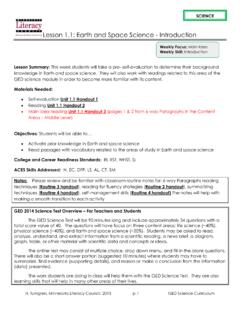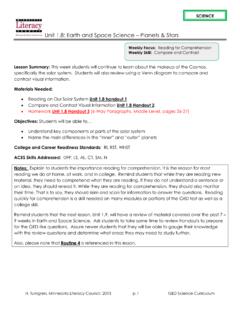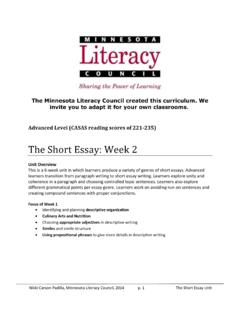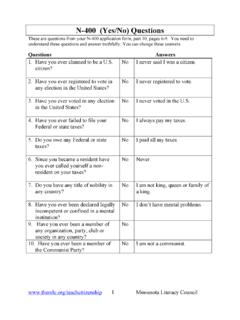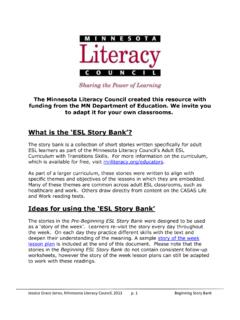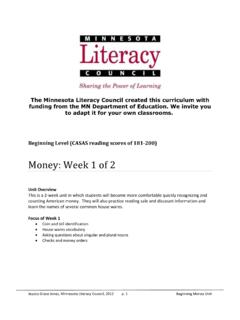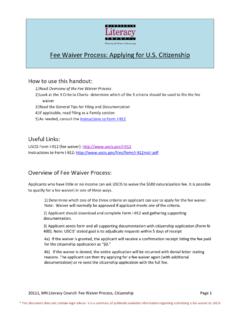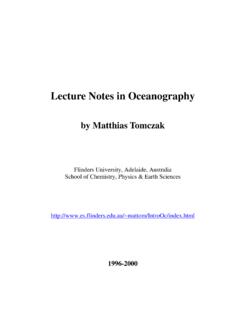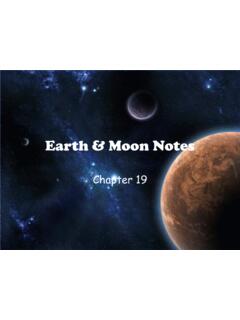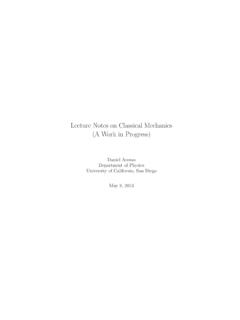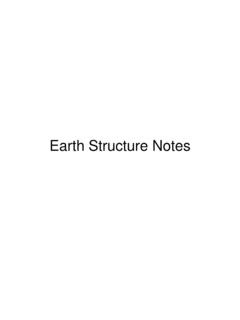Transcription of Lesson 1.1: Earth and Space Science - Introduction
1 Lesson : Earth and Space Science - Introduction H. Turngren, Minnesota Literacy Council, 2013 GED Science Curriculum Science Lesson Summary: This week students will take a pre- self-evaluation to determine their background knowledge in Earth and Space Science . They will also work with readings related to this area of the GED Science module in order to become more familiar with its content. Materials Needed: Self-evaluation Unit Handout 1 Reading Unit Handout 2 Main Idea reading Unit Handout 3 (pages 1 & 2 from 6-way Paragraphs in the Content Areas Middle Level) Objectives: Students will be able Activate prior knowledge in Earth and Space Science Read passages with vocabulary related to the areas of study in Earth and Space Science College and Career Readiness Standards: RI, RST, WHST, SL ACES Skills Addressed: N, EC, DFP, LS, AL, CT, SM notes : Please review and be familiar with classroom routine notes for.
2 6-way Paragraphs reading techniques (Routine 3 handout), reading for fluency strategies (Routine 2 handout), summarizing techniques (Routine 4 handout), self-management skills (Routine 4 handout) The notes will help with making a smooth transition to each activity GED 2014 Science Test Overview For Teachers and Students The GED Science Test will be 90 minutes long and include approximately 34 questions with a total score value of 40. The questions will have focus on three content areas: life Science (~40%), physical Science (~40%), and Earth and Space Science (~20%).
3 Students may be asked to read, analyze, understand, and extract information from a scientific reading, a news brief, a diagram, graph, table, or other material with scientific data and concepts or ideas. The online test may consist of multiple choice, drop down menu, and fill-in-the-blank questions. There will also be a short answer portion (suggested 10 minutes) where students may have to summarize, find evidence (supporting details), and reason or make a conclusion from the information (data) presented. The work students are doing in class will help them with the GED Science Test.
4 They are also learning skills that will help in many other areas of their lives. Weekly Focus: Main Idea Weekly Skill: Introduction Lesson : Earth and Space Science - Introduction H. Turngren, Minnesota Literacy Council, 2013 GED Science Curriculum Science Activities: Warm-Up: Time: 15 minutes As students enter the class, have students write in their journals, on a piece of notebook paper, or discuss with small groups the following: What do you think is involved in the study of Earth and Space Science ? Note: write the question on the board or overhead.
5 Circulate while students are writing. If students seem to be stuck with this question, try to prompt them with questions about what they already know about Science and what Science they have studied. Activity 1: Pre- self-evaluation (Unit 1 Handout 1) Time: 10 minutes 1) Hand out a self-evaluation sheet (Unit 1- Handout 1) for students. 2) Have student rate their background knowledge of Earth and Space Science by using the Likert rating scale. Remind students this is a way for them to assess their own knowledge and determine which areas they may need to work on during this unit.
6 3) Check to see if students are comfortable with sharing their self-evaluations, you can ask them how they answered each question, or they can share in pairs or table groups. 4) Remind students to keep the evaluation in their folder/binder/notebook. Students will reassess with the bottom portion of the sheet (Unit Handout 1) at the end of the unit. Activity 2: Introduction to Earth & Space Science (Unit 1 Handout 2) Jigsaw Reading & Reporting Time: 30 minutes 1) Put students into groups of 4 and label each group: A, B, C, D. 2) Hand out one section of the reading in Unit Handout 2 (labeled Group A, B, C, D) to appropriate group.
7 3) Ask students to read their section individually and become experts of the material for their group. 4) Have students turn their papers over and discuss with their group what their section is about. Tell students they should also discuss how they, as a group, will present the material to the class. Circulate to make sure students understand the objective and begin the discussion. 5) Explain to students will present their portion of the reading to the class. While they are presenting, the other groups will take notes of the material. 6) If time permits or for homework extension, students can do work on Page 2 of handout (to be printed on the back of Page 1).
8 Note: this may be an excellent opportunity for teacher to discuss Greek & Latin roots (geo = Earth , ology = study of, astro = star, meteor = atmosphere, etc.) Break: 10 minutes Activity 3: Main Idea Reading (Unit 1 Handout 3) Time: 45 minutes 1) Hand out (Unit Handout 3) for students. 2) Explain how to use the 6-way Paragraph readings from Routine 3 Handout. 3) Explain to students they should read passage silently and then answer questions. 4) Review answers as a whole class 5) Explain reading strategies from Routine 2 Handout and model fluent reading of passage while students highlight new vocabulary and read silently along 6) teacher reviews vocabulary students highlighted 7) Have students read passage to each other in pairs Note: Classroom Routine 2 notes are used extensively in this activity.
9 Lesson : Earth and Space Science - Introduction H. Turngren, Minnesota Literacy Council, 2013 GED Science Curriculum Science Wrap-Up: Summarize Time: 5 minutes Have students turn to a partner (or write in their journals) about what they have learned today about Earth and Space Science . Note: Use Routine 4 Handout Extra Work/Homework: Time: 30 minutes outside of class Students can look at careers in Earth and Space Science : go to - type in Earth Science in the search for careers field to get information on careers in Earth Science .
10 Differentiated Instruction/ELL Accommodation Suggestions Activity If some student groups finish early, they can turn their paper over and brainstorm for reasons why their field of study topic in Earth and Space Science is important for society. Handout Teachers should be aware that ELLs could have some difficult time with pronunciation of some vocabulary during the group presentation. Online Resources: Suggested Teacher Readings: GED Testing Service GED Science Item Sample (to get an idea of what the test may be like) Assessment Guide for Educators: A guide to the 2014 assessment content from GED Testing Service: Minnesota is getting ready for the 2014 GED test!
